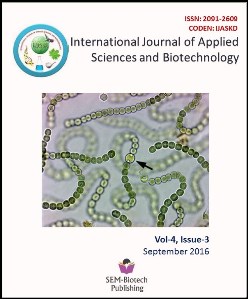Agromorphological Characterisation of Foxtail Millet (Setaria italica L. Beauv) at Rampur, Chitwan, Nepal
DOI:
https://doi.org/10.3126/ijasbt.v4i3.15148Keywords:
Foxtail millet, Setaria italica, agromorphological characterization, cluster analysisAbstract
Ten foxtail millet accessions were collected from different parts of Nepal and were characterized for different agro morphological traits at Institute of Agriculture and Animal Science, Rampur, Chitwan. Ten accessions were experimented in Randomized Complete Block Design with three replications. Observations were taken for quantitative traits i.e. days to heading, days to anthesis, days to maturity, peduncle length, plant height, flag leaf length, flag leaf breadth, flag leaf length breadth ratio and stay green period and yield attributing traits i.e. panicle length, panicle exertion, number of panicle per square meter, hundred grain weight, five panicle weight and yield per plant. The mean performance was obtained and correlation analysis was performed between grain yield and other traits. Observations were also taken for qualitative traits i.e. tip of first leaf, anthocyanin at leaf base, lobe compactness, length of bristles, anthocyanin presence, leaf blade altitude, flag leaf color, lobe in panicles, panicle lodging, inflorescence compactness, overall color, panicle anthocyanin, panicle shape and growth habit. Significant differences were observed among the accessions for many characters. Based on quantitative and yield attributing traits, Humla-149 was considered the best performing accession. The UPGMA clustering and PCA analysis revealed three distinct clusters of the studied accessions. Most closely related accessions were Co-1896 and Co-5645 and most distantly related accessions were Co-1896 and Humla-522.
Int J Appl Sci Biotechnol, Vol 4(3): 298-307




